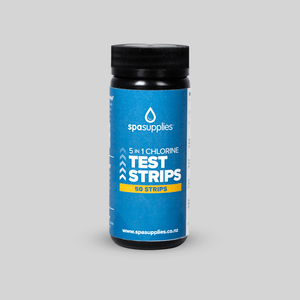Water in your spa pool can be likened to the air we breathe - when it's pure and clean, it's invigorating and refreshing. But when neglected, it can become a breeding ground for bacteria and algae, compromising the health of bathers and potentially causing damage to your spa's internal systems. This is why you’ll find that every spa pool manufacturer in the world underscores the requirement for water testing in their warranty and owner's guide.
Weekly water testing with "Test Strips" gives you all the insights you need to ensure that pH levels, alkalinity, and sanitizer levels are within safe and optimal ranges.
How Often Should I Test the Water?
To keep your spa water in healthy condition, testing your water weekly is vital.
This quick weekly check-up helps you stay ahead of any potential issues, adjusting chemical levels as needed to counteract the natural changes that occur with regular use. Whether it's after a party or just the weekly routine, these checks are your spa pool's best defense against the unseen threats that can turn clear waters cloudy and inviting spaces into no-go zones.
Should I Still Test if the Water Looks Clear?
Regardless of the water clarity or appearance, it is important to test weekly. Clear water can still harbor invisible chemical imbalances that pose risks to both bathers and the spa pool itself. For example, the water could have the right amount of sanitizer yet still suffer from pH imbalances or high levels of dissolved solids that aren't visible to the naked eye. These imbalances can lead to skin and eye irritation for users and accelerate wear and tear on your spa pool's components.
How to use Your Test Strips
Testing your spa pool's water might sound like complicated task, but it’s something anyone can do. Here’s how:1. Submerge the test strip in your spa water, horizontally, for about 2 seconds, then remove. Hold it still in the air, without shaking off the excess water.
2. After waiting for the time specified on the test strip bottle (usually about 15 seconds), compare the colors on the strip to the guide on the bottle. This will indicate your spa’s pH, alkalinity, and sanitizer levels.
3. Based on the results, add chemicals to balance your spa’s water. Always refer to the spa pool’s water care guide for the correct amounts.
What Happens If I Don't Test the Water?
Not testing your water can lead to several issues, affecting both the health of the bathers and the condition of the spa itself.
1. Bacterial Growth and Health Risks: Without frequent testing and balancing, your spa pool can quickly become a breeding ground for bacteria and other harmful microorganisms.
2. Damage to Spa Equipment: Water with improper chemical balance can be corrosive or cause scaling, leading to significant damage to your spa's heating elements, pumps, and filtration system. This can result in costly repairs and shorten the lifespan of your spa.
3. Cloudy and Uninviting Water: imbalanced water can turn crystal clear spa water into a cloudy, murky mess. This not only detracts from the inviting aesthetic of your spa but can also signal the presence of high levels of contaminants and chemicals, making it unsafe for use.



